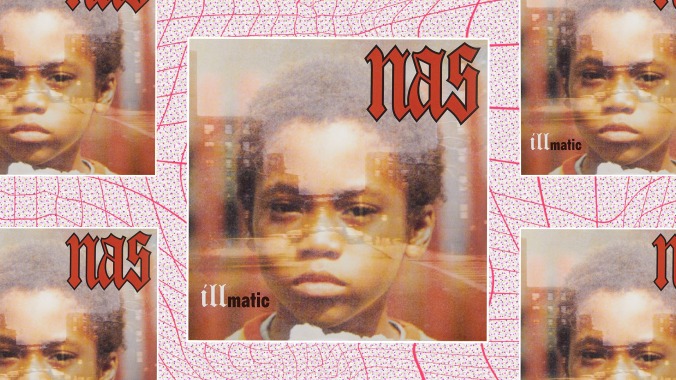The Game Ain’t the Same: Nas’ Illmatic at 30
On this day in 1994, the New York MC released a conscious debut that cut through the noise of socioeconomic inequality, gang violence and the emotional turmoil with pensive verses, stellar flow and a blueprint for brilliance. It also endures as one of the greatest albums of all time across all genres.

Throughout the year, Paste will be looking at the most important album releases from 1994 as they turn 30, from Portishead to Tom Petty to Pavement and beyond. This is 1994, She’s in Your Bones, a column of essays dedicated to one of the best years in rock ‘n’ roll history. Read our previous installments, on Hole’s Live Through This and Pulp’s His ‘n’ Hers.
It’s a full manifestation that some of the best hip-hop records come from the genre’s place of birth—New York City. A city comprised of movers and shakers, rappers and hip-hop artists have long captured the city’s magic, while detailing the ever-present struggles of making it in the city. On Nas’ debut album Illmatic—which turns 30 today—the then-20-year-old, promising newcomer introduces himself as a tenacious go-getter with a hunger for more. Amid socioeconomic inequality, gang violence and the emotional turmoil that accompanies these phenomena in Black communities, Nas was on a mission to make it. Upon its arrival, Illmatic became the motivation the world needed then, and endures as what it needs now.
The early 1990s delivered some of the best East Coast hip-hop albums of all time—including Wu-Tang Clan’s Enter the Wu-Tang (36 Chambers) and the Notorious B.I.G.’s Ready To Die. But as a fresh newcomer, Nas—hailing from New York’s Queensbridge neighborhood, a launching pad for the likes of Marly Marl and Roxanne Shante—was determined to prove he could sit among the greats. In 1992, two years before em>Illmatic’s release, Nas’ brother and best friend were shot—the former survived, but the latter passed away. When he spoke with Time in a 1994 interview, Nas described the moment as a “wake-up call.”
On “Life’s A Bitch,” a standout from Illmatic—which has gone on to be one of Nas’ universal songs—he ponders his mortality having moved through the wreckage of Queensbridge, and he uses this as motivation to keep his pen to the paper and his foot on the gas. An empowering opening verse and chorus by AZ—“Life’s a bitch and then you die / That’s why we get high / ‘Cause you never know when you’re gonna go”—paired with a cornet solo by Nas’ father, jazz musician Olu Dara, make the song a powerful community affair.
Over the course of Nas’ career, “Life’s A Bitch” has served as the foundation to many of his projects, including the song “Affirmative Action” from his 1996 follow-up It Was Written—“Life’s a bitch, but God forbid the bitch divorce me,” he rapped 28 years ago. His 2012 album, Life Is Good, which was largely inspired by his divorce from singer Kelis, features a well-decorated Nas celebrating the accomplishments he had been striving to attain 18 years prior and more. “Success is my three-year-old son having full-on conversations with me,” Nas said in a 2012 interview with Billboard. “This is coming from the guy that first told you ‘life’s a bitch.’ I just enjoy life now. I just enjoy every morning I get to wake up.”
From the beginning, Nas had the zeal to accomplish what he put his mind to. The Scarface-inspired “The World Is Yours” features Nas laying the groundwork for his future as a GOAT in hip-hop, and a mission to give back to the community that brought him up. On the song’s chorus, Nas and Pete Rock continue to ask “Whose world is this?” repeating “It’s mine, it’s mine, it’s mine” in call-and-response fashion over a hopeful, jazzy track. According to Rock, he and Nas—alongside DJ Premier—cut the song upon their first meeting. In a 2014 interview with XXL, Rock recalled how the song came together after the artists were able to match each other’s energy in the studio: “We were in my basement,” he said. “Large Professor had brought him over. That’s when I actually first met Nas, when Large brought him up to Mount Vernon. We went through beats and stumbled across that one. It wasn’t like I made it then. It was already made, so I just popped the disc in, and he was like, “Yo!” Next thing you know, we in Battery Studios knocking it down. When I was doing the scratches, Preemo was there. He was just standing there, looking in amazement, and I was like, “Come on…You that dude, too.”
-

-

-

-

-

-

-

-

-

-

-

-

-

-

-

-

-

-

-

-

-

-

-

-

-

-

-

-

-

-

-

-

-

-

-

-

-

-

-

-








































